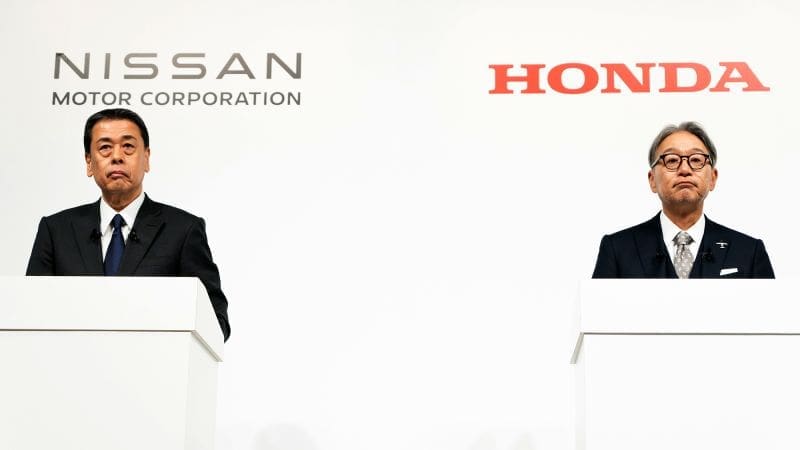Nissan and Honda are reportedly engaging in multiple discussions amidst media claims about a potential halt in their merger talks. These speculations arise despite a prior announcement by the companies in December, which suggested a six-month long negotiation to explore a merger. This strategic merger could pave the way for creating the third-largest global automaker.
The media outlets Kyodo News and Nikkei have indicated a possible cessation of these talks. Nissan has responded, clarifying the absence of any formal decision to withdraw from the merger discussions. The course of action will likely be defined by mid-February, as indicated by Nissan in its statements. The merger’s potential is under scrutiny given the threat posed by Chinese competitors.
Merger Background
Nissan and Honda initiated merger talks in December, identifying a partnership that could potentially position them as the world’s third-largest automaker. The primary goal was to consolidate their strengths and better compete with advancing Chinese automotive manufacturers. Both companies aimed to use their combined resources to fortify their market stance.
The merger talks suggested a strategic alignment, which was enticing due to both companies’ overlapping strengths in vehicle production and technology. However, there are concerns regarding managerial integration and strategic alignment that need addressing. Such mergers bring the challenge of synchronizing business visions and operational frameworks.
Current State of Discussions
Recent reports by Kyodo News and the Nikkei newspaper indicate a possible discontinuation of the merger talks. Nissan, however, notes that such reports are not a direct reflection of the company’s decisions. They reaffirm that discussions are ongoing as per the ‘memorandum of understanding’ signed last year.
As the negotiations continue, it’s clear that both parties are still in the exploratory phases. This collaboration could redefine market dynamics if successful. The complexity of such corporate mergers involves meticulous planning and agreement on various factors.
Statements from Nissan
Nissan has publicly addressed these reports saying that no official cessation of the merger talks has been declared. The company emphasized, “Based on our ongoing discussions, any decision will be communicated around mid-February.” This suggests ongoing evaluation and the importance of clear strategy articulation.
Nissan seems determined to manage public perception carefully while navigating these delicate discussions. Their statements reinforce that, despite speculative reports, there is still potential for a merger, contingent on internal alignments and negotiations outcomes.
The carmaker remains committed to portraying transparency and commitment to stakeholders. However, aligning interests and strategies with Honda remains a pivotal aspect of these discussions.
Obstacles in the Merger Path
One significant hurdle in the merger process has been the resistance faced internally by Nissan. Reports suggest a reluctance from within Nissan towards becoming a subsidiary of Honda, which has led to stagnation in discussions.
Honda’s proposal envisioned Nissan as a subsidiary, an idea which met stiff opposition within Nissan ranks. Such dynamics highlight potential power struggles and differing perspectives among corporate leadership.
Nissan’s current restructuring plan has also been under scrutiny, failing to convince Honda of its turnaround capability. For a merger to proceed, there needs to be demonstrated synergy in business objectives and operational strategies.
Leadership Dynamics
The leadership of Nissan, under CEO Makoto Uchida, faces the challenge of navigating this complex merger terrain. Honda’s leadership, with President Toshihiro Mibe, is similarly positioned to ensure favorable outcomes for both companies.
There have been strategic discussions at various leadership levels to ensure alignment of visions. Both companies aim to resolve strategic and operational differences before committing to any merger agreement. Leadership decisions will play a crucial role in determining the merger’s trajectory.
Strategic alignment between both leaders is indispensable for a smooth integration. As discussions advance, clarity in strategic direction becomes crucial in minimizing organizational frictions.
Potential Role of Mitsubishi
Mitsubishi, already in an alliance with Nissan, was also expected to take part in these talks. Their involvement could have added an interesting dynamic and increased bargaining power for Nissan in negotiations with Honda.
Mitsubishi’s potential role underscores the collaborative opportunities that could arise if the merger materializes. Their partnership could provide broader strategic advantages, pooling together resources and market insights.
However, any discussions with Mitsubishi have not been highlighted prominently in recent reports. Their participation remains speculative at this stage, contingent on developments in ongoing talks.
Impact on the Global Automotive Market
The potential merger between Nissan and Honda holds substantial implications for the global automotive sector, possibly reshaping competitive dynamics. Both companies face increasing competition from Chinese automakers.
Combining their resources could potentially offer a competitive edge, fostering innovations and expansions in emerging markets. The merger would need to address not only production capabilities but also technological advancements and brand strategies.
In this era of automotive consolidation, such a merger could create a formidable entity, influencing market trends and consumer preferences globally.
Financial Considerations
Nissan has faced severe financial challenges, primarily stemming from its previous dissolution with Renault. This pressure accentuates the need for a merger to stabilize its financial standing.
The financial incentives for Nissan to merge with Honda include potential cost efficiencies and market share expansions. However, merger success depends heavily on thorough financial evaluations and mutual agreements on profit-sharing models.
The financial landscape will play a critical role in the negotiations, dictating the merger’s viability and potential synergies.
Future Outlook
As both companies continue discussions, an official announcement is anticipated around mid-February. This timeframe suggests that critical evaluations and strategic planning are currently underway.
The automotive industry’s landscape could witness considerable shifts if the merger materializes. Clarity on direction and effective communication with stakeholders will be paramount for both Nissan and Honda.
While the outcome remains uncertain, ongoing discussions indicate persistent interest in exploring the merger’s feasibility. Both companies appear committed to evaluating all potential benefits and risks.
Should the discussions progress favorably, this merger could symbolize a new era of collaboration, enhancing both companies’ global presence and capabilities.
The discussions between Nissan and Honda are pivotal in shaping their potential merger’s trajectory. As both companies navigate these complex negotiations, the outcome could indeed redefine their roles in the automotive sector. Continued stakeholder engagement and transparent communication will be essential in steering this possible transition.








